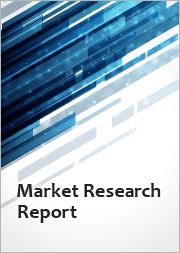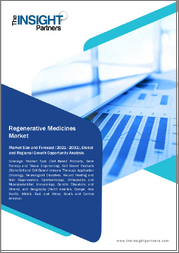
|
시장보고서
상품코드
1565909
세계의 재생의료 시장 : 시장 규모, 점유율, 예측, 동향 분석 - 제품별, 용도별, 최종사용자별, 예측(-2031년)Regenerative Medicine Market Size, Share, Forecast, & Trends Analysis by Product Application End User - Global Forecast to 2031 |
||||||
세계 재생의료 시장 규모는 2024년부터 2031년까지 연평균 21.5% 성장하여 2031년까지 372억 7,000만 달러에 달할 것으로 예상됩니다.
이 보고서는 광범위한 2차 및 1차 조사, 시장 시나리오에 대한 심층 분석을 통해 주요 산업 촉진요인, 억제요인, 도전 과제 및 기회 분석으로 구성됩니다.
세계 재생의료 시장의 성장은 새로운 재생의료 승인 증가, 재생의료의 발전, 만성질환 유병률 증가, 재생의료 개발을 위한 자금 조달 증가, 새로운 치료 영역에서의 재생의료 적용 확대 등이 원동력이 되고 있습니다. 그러나 높은 치료 비용과 줄기세포와 관련된 윤리적 문제가 이 시장의 성장을 저해하고 있습니다.
또한, 개인 맞춤형 의료에 대한 수요 증가, 장기 이식 수술 건수 증가, 재생의료에 대한 강력한 제품 파이프라인은 시장 성장 기회를 창출할 것으로 예상됩니다. 그러나 불리한 상환 정책, 재생의료 제조의 복잡성, 재생의료의 안전성 및 유효성에 대한 표준화된 프레임워크의 부재는 세계 재생의료 시장의 주요 도전 과제입니다.
이 보고서는 제품 포트폴리오 제공, 지역적 상황, 지난 3-4년(2020-2024년) 동안 주요 시장 기업들이 채택한 주요 전략적 개발에 대한 광범위한 평가를 바탕으로 경쟁 환경을 제공합니다. 재생의료 시장에 진출한 주요 기업으로는 Novartis AG(스위스), Biogen Inc.(미국), Sarepta Therapeutics, Inc.(미국), Takeda Pharmaceutical Company Limited(일본), Amgen Inc.(미국), CORESTEMCHEMON Inc, Vertex Pharmaceuticals Incorporated(미국), CSL Behring, LLC(미국), Janssen Global Services, LLC(미국), Medtronic plc(아일랜드), AbbVie Inc. -Myers Squibb Company(미국), Ferring Pharmaceuticals A/S(스웨덴), Pfizer Inc.(미국), bluebird bio Inc.(미국), Vericel Corporation(미국) 등이 있습니다.
이 보고서에서 조사한 전체 제품 중 세포 치료제 부문은 예측 기간 동안 25.0%의 가장 높은 CAGR을 기록할 것으로 예상됩니다. 세포 치료 분야는 줄기세포 치료, 세포 기반 면역 치료, 혈소판이 풍부한 혈장 치료로 세분화됩니다. 세포 기반 면역요법은 예측 기간 동안 가장 높은 CAGR을 기록할 것으로 예상됩니다. 이 분야의 급격한 성장은 암 발병률 증가, CAR T 세포 요법 사용에 대한 인식 증가, 세포 기반 면역요법 승인 및 임상시험 건수 증가에 기인합니다. 또한, 세포 기반 면역요법 개발 자금이 증가하면서 시장 성장을 더욱 촉진하고 있습니다. 예를 들어, 2024년 5월 독일 암 지원은 독일 라이프니츠 면역치료연구소(LIT)와 영국 레겐스부르크 대학병원(UKR)에 280만 달러(260만 유로)의 보조금을 지원했습니다. 이 보조금은 줄기세포 유사 CAR T 세포를 사용하여 진행성 림프종 환자를 치료하는 데 초점을 맞춘 임상 연구에 사용되었습니다.
이 보고서에서 조사한 모든 응용 분야 중 암 분야는 예측 기간 동안 26.5%의 가장 높은 CAGR을 기록할 것으로 예상됩니다. 재생의학은 줄기세포 치료, 유전자 치료, 조직공학 등 암 치료를 위한 다양한 접근법을 제공합니다. 이러한 접근법은 개별화된 치료 옵션을 제공하고 기존 암 치료와 관련된 부작용의 위험을 최소화하는 데 도움이 될 수 있습니다. 또한, 암 치료 연구에 대한 자금이 증가하고 있는 것도 이 부문의 성장에 기여하고 있습니다. 예를 들어, 2024년 2월 BioNTech SE(독일)는 Autolus Therapeutics(영국)에 2억 달러를 투자하여 암 치료 파이프라인을 지원하기 위한 전략적 협력 관계를 구축했습니다.
이 보고서에서 조사한 모든 최종사용자 중 병원 및 클리닉 부문은 예측 기간 동안 가장 높은 CAGR을 기록할 것으로 예상됩니다. 병원 및 클리닉은 인프라가 잘 갖추어져 있고, 고도로 숙련된 의료진을 보유하고 있으며, 접근성이 용이하고, 다양한 치료를 포함한 고급 치료를 제공합니다. 따라서 환자들은 병원 및 클리닉을 찾는 경향이 강합니다. 또한, 많은 병원들이 재생의료 전문 부서를 설립하여 시장 성장을 촉진하고 있습니다. 예를 들어, 2023년 4월 인도 자스락 병원(Jasrock Hospital)은 복잡한 질병을 치료하는 것을 목표로 하는 재생의료 부서를 개설했습니다. 이 부서는 뼈와 관절 장애에 대한 다양한 세포 기반 치료를 위한 성형 생물학적 제제 및 성형외과, 혈관 및 미용에 적용하기 위한 혈소판이 풍부한 혈장 치료제를 제공하고 있습니다.
세계 재생의료 시장의 지역별 시나리오에 대한 상세한 분석은 5개 주요 지역(북미, 유럽, 아시아태평양, 라틴아메리카, 중동 및 아프리카)에 대한 상세한 질적 및 양적 인사이트와 각 지역의 주요 국가에 대한 커버리지를 제공합니다. 아시아태평양은 예측 기간 동안 25.0%의 가장 높은 CAGR을 기록할 것으로 예상되며, 2024년에는 일본이 아시아태평양 재생의료 시장에서 가장 큰 점유율을 차지할 것으로 예상됩니다. 일본의 높은 시장 점유율은 65세 이상 인구가 많고, 재생의료 도입을 위한 정부의 노력과 재생의료 승인을 위한 지원적인 규제 프레임워크가 뒷받침되고 있기 때문입니다. 예를 들어, 일본은 재생의료 조건부 승인 제도를 도입하여 기업들이 새로운 치료법을 보다 빠르게 시장에 출시할 수 있도록 지원하고 있습니다. 또한, 국가 의료보험제도도 이러한 새로운 치료법을 다루고 있어 외국계 기업이 일본에서 제품을 도입할 수 있는 추가적인 인센티브를 제공하고 있습니다.
조사 범위:
재생의료 시장 평가 : 제품별
- 유전자 치료
- 세포 치료
- 줄기세포 치료
- 자가 요법
- 동종요법
- 혈소판풍부혈장 요법
- 세포 기반 면역요법
- 조직공학
재생의료 시장 평가 : 용도별
- 순환기
- 안과
- 종양학
- 신경학
- 면역-염증
- 근골격계
- 피부과
- 기타 용도
주: 기타 용도에는 상처 치료, 정형외과, 혈액 질환 등이 있습니다.
재생의료 시장 평가 : 최종사용자별
- 병원 및 진료소
- 외래수술센터
재생의료 시장 평가 : 지역별
- 북미
- 미국
- 캐나다
- 유럽
- 독일
- 프랑스
- 영국
- 이탈리아
- 스페인
- 스위스
- 네덜란드
- 스웨덴
- 기타 유럽
- 아시아태평양
- 중국
- 일본
- 인도
- 한국
- 호주
- 기타 아시아태평양
- 라틴아메리카
- 브라질
- 멕시코
- 기타 라틴아메리카
- 중동 및 아프리카
목차
제1장 소개
제2장 조사 방법
제3장 주요 요약
제4장 시장 인사이트
- 시장 개요
- 시장 성장에 영향을 미치는 요인
- 성장 촉진요인
- 신규 재생의료 승인
- 재생의료 개발자금 증가
- 새로운 치료 분야의 재생의료 응용 확대
- 성장 억제요인
- 줄기세포에 관한 윤리적 문제
- 기회
- 맞춤형 의료에 대한 수요 증가
- 과제
- 재생의료 제조의 복잡성
- 요인 분석
- 성장 촉진요인
- 동향
- 재생의료의 3D 바이오프린팅 활용
- 재생의료 개발의 AI툴의 통합
- 유도만능줄기세포
- 규제 분석
- 북미
- 미국
- 캐나다
- 아시아태평양
- 일본
- 중국
- 인도
- 유럽
- 중동 및 아프리카
- PRP 자격 기준
- 북미
- Porter's Five Forces 분석
- 투자와 자금 조달 시나리오
- 파이프라인 분석
제5장 재생의료 시장 평가 : 제품별
- 개요
- 세포 치료
- 세포 기반 면역요법
- 줄기세포 치료
- 동종요법
- 자가 요법
- 혈소판풍부혈장 요법
- 유전자 치료
- 조직공학 제품
제6장 재생의료 시장 평가 : 용도별
- 개요
- 근골격계
- 종양학
- 안과
- 면역·염증
- 신경학
- 피부과학
- 심장병학
- 기타 용도
제7장 재생의료 시장 평가 : 최종사용자별
- 소개
- 병원·클리닉
- 외래 수술 센터
제8장 재생의료 시장 평가 : 지역별
- 개요
- 북미
- 미국
- 캐나다
- 유럽
- 독일
- 영국
- 프랑스
- 스위스
- 이탈리아
- 스페인
- 네덜란드
- 스웨덴
- 기타 유럽
- 아시아태평양
- 일본
- 중국
- 호주
- 인도
- 한국
- 기타 아시아태평양
- 라틴아메리카
- 브라질
- 멕시코
- 기타 라틴아메리카
- 중동 및 아프리카
제9장 경쟁 분석
- 개요
- 주요 성장 전략
- 경쟁 벤치마킹
- 경쟁 대시보드
- 산업 리더
- 시장 차별화 요인
- 선행 기업
- 신흥 기업
- 시장 점유율 분석(2023년)
- Novartis AG(Switzerland)
- Kite Pharma, Inc.(U.S.)
- Biogen, Inc.(U.S.)
- Bristol-Myers Squibb Company(U.S.)
- Janssen Global Services, LLC(U.S.)
제10장 기업 개요
- Novartis AG
- Kite Pharma, Inc.(A Subsidiary of Gilead Sciences, Inc.)
- Janssen Global Services, LLC(A Subsidiary of Johnson & Johnson)
- Bristol-Myers Squibb Company
- Biogen Inc.
- Smith & Nephew Plc
- Amgen Inc.
- Vericel Corporation
- Integra Lifesciences Holdings Corporation
- Pfizer Inc.
- AbbVie Inc.
- Sarepta Therapeutics, Inc.
- Spark Therapeutics, Inc.(A Subsidiary of F. Hoffmann-La Roche Ag)
- CORESTEMCHEMON, Inc.
- CSL Behring, LLC(A Subsidiary of CSL Limited)
- Takeda Pharmaceutical Company Limited
- Ferring Pharmaceuticals
- Medtronic plc
- Bluebird Bio, Inc.
- Vertex Pharmaceuticals Incorporated
(참고 : 상위 5개사 SWOT 분석을 게재)
제11장 부록
ksm 24.10.21Regenerative Medicine Market Size, Share, Forecast, & Trends Analysis by Product (Gene Therapy, Stem Cell, Tissue Engineering) Application (Musculoskeletal, Cancer, Cardiovascular, Immunology, Dermatology, Ophthalmology) End User-Global Forecast to 2031
The global regenerative medicine market is projected to reach $37.27 billion by 2031 at a CAGR of 21.5% from 2024 to 2031.
Succeeding extensive secondary and primary research and in-depth analysis of the market scenario, the report comprises the analysis of key industry drivers, restraints, challenges, and opportunities.
The growth of the global regenerative medicine market is driven by increasing approvals for new regenerative medicines, advancements in regenerative medicine, the rising incidence of chronic diseases, increasing funding for regenerative medicine development, and the growing applications of regenerative medicine in newer therapeutic areas. However, high treatment costs and ethical issues related to stem cells restrain the growth of this market.
Furthermore, the rising demand for personalized medicines, the increasing number of organ transplant procedures, and the strong product pipeline for regenerative medicines are expected to generate market growth opportunities. However, unfavorable reimbursement policies, complexities in the manufacture of regenerative medicines, and the lack of standardized frameworks for the safety & efficacy of regenerative medicines are major challenges in the global regenerative medicine market.
The report offers a competitive landscape based on an extensive assessment of the product portfolio offerings, geographic presences, and key strategic developments adopted by leading market players in the industry in the last three to four years (2020-2024). The key players operating in the regenerative medicine market are Novartis AG (Switzerland), Biogen Inc. (U.S.), Kite Pharma, Inc. (U.S.), Spark Therapeutics, Inc. (U.S.), Integra LifeSciences Corporation (U.S.), Sarepta Therapeutics, Inc. (U.S.), Takeda Pharmaceutical Company Limited (Japan), Amgen Inc. (U.S.), CORESTEMCHEMON Inc. (South Korea), Smith & Nephew plc (England), Vertex Pharmaceuticals Incorporated (U.S.), CSL Behring, LLC (U.S.), Janssen Global Services, LLC (U.S.), Medtronic plc (Ireland), AbbVie Inc. (U.S.), Bristol-Myers Squibb Company (U.S.), Ferring Pharmaceuticals A/S (Sweden), Pfizer Inc. (U.S.), bluebird bio Inc. (U.S.), and Vericel Corporation (U.S.).
Among all the products studied in this report, the cell therapy segment is projected to register the highest CAGR of 25.0% during the forecast period. The cell therapy segment is further segmented into stem cell therapy, cell-based immunotherapy, and platelet-rich plasma therapy. Cell-based immunotherapy is projected to register the highest CAGR during the forecast period. The rapid growth of this segment is attributed to the increasing cancer prevalence, rising awareness regarding the use of CAR T-cell therapy, and rising number of approvals & clinical trials for cell-based immunotherapy. The funding for the development of cell-based immunotherapy is also increasing, further driving the market growth. For instance, in May 2024, German Cancer Aid provided a $2.8 million (€2.6 million) grant to the Leibniz Institute for Immunotherapy (LIT) and University Hospital Regensburg (UKR) (Germany). The funding was earmarked for a clinical study focused on the use of stem-like CAR T-cells to treat patients with advanced lymphomas.
Among all the applications studied in this report, the oncology segment is projected to register the highest CAGR of 26.5% during the forecast period. Regenerative medicine offers various approaches, such as stem cell therapy, gene therapy, and tissue engineering, for treating cancer. These approaches provide personalized treatment options and help minimize the risk of side effects associated with traditional cancer treatments. Additionally, the rising funding for cancer treatment research contributes to the growth of this segment. For instance, in February 2024, BioNTech SE (Germany) invested USD 200 million in Autolus Therapeutics (U.K.) and established a strategic collaboration to support the cancer therapy pipeline.
Among all the end users studied in this report, the hospitals and clinics segment is projected to register the highest CAGR during the forecast period. Hospitals & clinics have developed infrastructure and highly skilled healthcare professionals, are easily accessible, and offer advanced treatments, including various therapies. Hence, patients are more inclined toward visiting hospitals & clinics. Many hospitals are also launching dedicated units for regenerative medicine, driving market growth. For instance, in April 2023, Jaslok Hospital (India) opened a Restorative and Regenerative Medicine Department aimed at treating complex diseases. This department offers orthobiologics for various cell-based treatments for bone and joint disorders, as well as platelet-rich plasma therapies for orthopedic, vascular, and cosmetic applications.
An in-depth analysis of the geographical scenario of the global regenerative medicine market provides detailed qualitative and quantitative insights into the five major geographies (North America, Europe, Asia-Pacific, Latin America, and the Middle East & Africa) along with the coverage of major countries in each region. Asia-Pacific is projected to register the highest CAGR of 25.0% during the forecast period. In 2024, Japan is expected to account for the largest share of the regenerative medicine market in Asia-Pacific. The large market share of Japan is attributed to the large population base aged 65 and older, government initiatives for the adoption of regenerative medicine, and supportive regulatory framework for the approval of regenerative medicine. For instance, Japan has implemented a conditional approval system for regenerative medicine, allowing companies to bring new therapies to market more quickly. The national healthcare system also covers these new therapies, providing further incentives for foreign companies to introduce their products in Japan.
Scope of the Report:
Regenerative Medicine Market Assessment-by Product
- Gene Therapy
- Cell Therapy
- Stem Cell Therapy
- Autologous Therapy
- Allogenic Therapy
- Platelet Rich Plasma Therapy
- Cell-based Immunotherapy
- Tissue Engineering
Regenerative Medicine Market Assessment-by Application
- Cardiology
- Ophthalmology
- Oncology
- Neurology
- Immunology & Inflammation
- Musculoskeletal
- Dermatology
- Other Applications
Note: Other Applications include wound care, orthopedics, and blood disorders
Regenerative Medicine Market Assessment-by End User
- Hospitals & Clinics
- Ambulatory Surgical Centers
Regenerative Medicine Market Assessment-by Geography
- North America
- U.S.
- Canada
- Europe
- Germany
- France
- U.K
- Italy
- Spain
- Switzerland
- Netherlands
- Sweden
- Rest of Europe
- Asia-Pacific
- China
- Japan
- India
- South Korea
- Australia
- Rest of Asia-Pacific
- Latin America
- Brazil
- Mexico
- Rest of Latin America
- Middle East & Africa
TABLE OF CONTENTS
1. Introduction
- 1.1. Market Definition & Scope
- 1.2. Market Ecosystem
- 1.3. Currency and Limitations
- 1.4. Key Stakeholders
2. Research Methodology
- 2.1. Research Process
- 2.2. Data Collection and Validation Process
- 2.2.1. Secondary Research
- 2.2.2. Primary Research/Interviews With Key Opinion Leaders from the Industry
- 2.3. Market Sizing & Forecasting
- 2.3.1. Market Size Estimation Approach
- 2.3.2. Growth Forecast Approach
- 2.3.3. Market Share Analysis
- 2.4. Assumptions for the Study
3. Executive Summary
4. Market Insights
- 4.1. Overview
- 4.2. Factors Affecting Market Growth
- 4.2.1. Drivers
- 4.2.1.1. Approvals for New Regenerative Medicines
- 4.2.1.2. Increasing Funding for Regenerative Medicine Development
- 4.2.1.3. Increasing Applications of Regenerative Medicine in Newer Therapy Areas
- 4.2.2. Restraints
- 4.2.2.1. Ethical Issues Related to Stem Cells
- 4.2.3. Opportunities
- 4.2.3.1. Rising Demand for Personalized Medicines
- 4.2.4. Challenges
- 4.2.4.1. Complexities in the Manufacture of Regenerative Medicines
- 4.2.5. Factor Analysis
- 4.2.1. Drivers
- 4.3. Trends
- 4.3.1. Utilization of 3D Bioprinting in Regenerative Medicine
- 4.3.2. Integration of AI Tools in Regenerative Medicine Development
- 4.3.3. Induced Pluripotent Stem Cells
- 4.4. Regulatory Analysis
- 4.4.1. North America
- 4.4.1.1. U.S.
- 4.4.1.2. Canada
- 4.4.2. Asia-Pacific
- 4.4.2.1. Japan
- 4.4.2.2. China
- 4.4.2.3. India
- 4.4.3. Europe
- 4.4.4. Middle East & Africa
- 4.4.5. PRP Qualification Criteria
- 4.4.1. North America
- 4.5. Porter's Five Forces Analysis
- 4.5.1. Bargaining Power of Suppliers
- 4.5.2. Bargaining Power of Buyers
- 4.5.3. Threat of Substitutes
- 4.5.4. Threat of New Entrants
- 4.5.5. Degree of Competition
- 4.6. Investment and Funding Scenario
- 4.7. Pipeline Analysis
5. Regenerative Medicine Market Assessment-by Product
- 5.1. Overview
- 5.2. Cell Therapy
- 5.2.1. Cell-based Immunotherapy
- 5.2.2. Stem Cell Therapy
- 5.2.2.1. Allogenic Therapy
- 5.2.2.2. Autologous Therapy
- 5.2.3. Platelet-rich Plasma Therapy
- 5.3. Gene Therapy
- 5.4. Tissue Engineering Products
6. Regenerative Medicine Market Assessment-by Application
- 6.1. Overview
- 6.2. Musculoskeletal
- 6.3. Oncology
- 6.4. Ophthalmology
- 6.5. Immunology & Inflammation
- 6.6. Neurology
- 6.7. Dermatology
- 6.8. Cardiology
- 6.9. Other Applications
7. Regenerative Medicine Market Assessment-by End User
- 7.1. Introduction
- 7.2. Hospitals & Clinics
- 7.3. Ambulatory Surgical Centers
8. Regenerative Medicine Market Assessment-by Geography
- 8.1. Overview
- 8.2. North America
- 8.2.1. U.S.
- 8.2.2. Canada
- 8.3. Europe
- 8.3.1. Germany
- 8.3.2. U.K.
- 8.3.3. France
- 8.3.4. Switzerland
- 8.3.5. Italy
- 8.3.6. Spain
- 8.3.7. Netherlands
- 8.3.8. Sweden
- 8.3.9. Rest of Europe
- 8.4. Asia-Pacific
- 8.4.1. Japan
- 8.4.2. China
- 8.4.3. Australia
- 8.4.4. India
- 8.4.5. South Korea
- 8.4.6. Rest of Asia-Pacific
- 8.5. Latin America
- 8.5.1. Brazil
- 8.5.2. Mexico
- 8.5.3. Rest of Latin America
- 8.6. Middle East & Africa
9. Competition Analysis
- 9.1. Overview
- 9.2. Key Growth Strategies
- 9.3. Competitive Benchmarking
- 9.4. Competitive Dashboard
- 9.4.1. Industry Leaders
- 9.4.2. Market Differentiators
- 9.4.3. Vanguards
- 9.4.4. Emerging Companies
- 9.5. Market Share Analysis (2023)
- 9.5.1. Novartis AG (Switzerland)
- 9.5.2. Kite Pharma, Inc. (U.S.)
- 9.5.3. Biogen, Inc. (U.S.)
- 9.5.4. Bristol-Myers Squibb Company (U.S.)
- 9.5.5. Janssen Global Services, LLC (U.S.)
10. Company Profiles (Business Overview, Financial Overview, Product Portfolio, Strategic Developments, SWOT Analysis*)
- 10.1. Novartis AG
- 10.2. Kite Pharma, Inc. (A Subsidiary of Gilead Sciences, Inc.)
- 10.3. Janssen Global Services, LLC (A Subsidiary of Johnson & Johnson)
- 10.4. Bristol-Myers Squibb Company
- 10.5. Biogen Inc.
- 10.6. Smith & Nephew Plc
- 10.7. Amgen Inc.
- 10.8. Vericel Corporation
- 10.9. Integra Lifesciences Holdings Corporation
- 10.10. Pfizer Inc.
- 10.11. AbbVie Inc.
- 10.12. Sarepta Therapeutics, Inc.
- 10.13. Spark Therapeutics, Inc. (A Subsidiary of F. Hoffmann-La Roche Ag)
- 10.14. CORESTEMCHEMON, Inc.
- 10.15. CSL Behring, LLC (A Subsidiary of CSL Limited)
- 10.16. Takeda Pharmaceutical Company Limited
- 10.17. Ferring Pharmaceuticals
- 10.18. Medtronic plc
- 10.19. Bluebird Bio, Inc.
- 10.20. Vertex Pharmaceuticals Incorporated
(Note: SWOT Analysis of the Top 5 Companies Will Be Provided)
11. Appendix
- 11.1. Available Customization
- 11.2. Related Reports



















